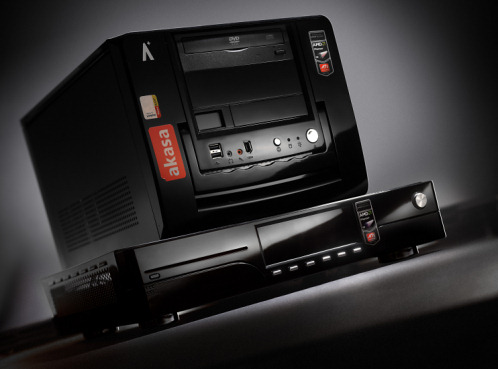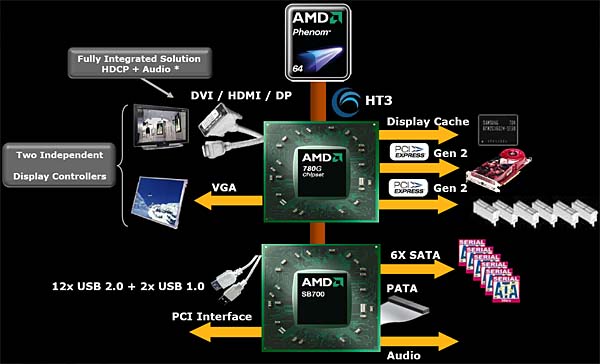We've examined several motherboards on AMD 780G already: full-size ATX ECS A780GM-A, feature-rich microATX Gigabyte MA78GM-S2H, and frugal Biostar TA780G M2+. However, some performance matters were not covered. For example, operation with a discrete graphics card in Hybrid CrossFire mode as well as HD video decoding. To be more exact, they were waiting in the wings for a traditional "personal" review of the chipset. Now we finally publish it. Besides, the 780G chipset was launched together with pared-down modifications (780V and 740G), which are also interesting in their own ways. But let's not put the cart before the horse.
AMD 780G
The key innovation in the AMD 780G Northbridge is its graphics core's support (Radeon HD 3200) for DirectX 10. Moreover, engineers managed to expand functionality of the pipelines for the hardware implementation of the new DirectX version and double performance of the graphics core. It was possible owing to the upgrade from the 80-nm right to the 55-nm fabrication process. The number of transistors has grown almost threefold from 72 to 205 millions, if we compare with AMD 690G. And the frequency was raised (from 400 MHz to 500 MHz). Moreover, higher frequencies are available in the overclocked mode (up to double values). The graphics core contains 40 unified shader processors, 4 texture units, and 4 ROPs. The chipset operating at the nominal frequency dissipates 11.4 W under maximum load, and 0.94 W in idle mode. These are low values (a compact heat sink will be sufficient to dissipate such power), lower than in competing chipsets (14 W in GeForce 8200 and 28 W in Intel G35).
The second highlight is the UVD unit - AMD cards got this unit last year in Autumn with the rollout of Radeon HD 3000. It takes the full load of decoding HD video in three formats (VC1, H.264, and MPEG2), provided your player can use DXVA functions, for example, CyberLink PowerDVD, free Media Player Classic, KMPlayer, and many others (in fact, it's not important what player is used, any player you like will do, if it allows to add external decoders; you can take them from PowerDVD, for example). Besides, two HD video streams can be decoded simultaneously (dual video stream).
A graphics card can be installed into PCI Express x16 2.0 slot not only for configurations with up to four monitors (in Surround View mode - to join all monitors into a common desktop), but also to use Hybrid CrossFire. This mode is available, if you install graphics cards on Radeon HD 2400PRO/XT and HD 3450/3470 GPUs (their performance is comparable to the graphics core in the chipset). It allows to pool resources of graphics cores for 3D rendering. Video outputs on the cards can include analog VGA as well as digital DVI, HDMI (which can output not only video, but also audio in the most popular formats: stereo and Dolby Digital 5.1), and even DisplayPort, which support is also integrated into the chipset. However, cards with several digital outputs allow to use only one connector together with the analog output. Theoretically, the AMD 690G chipset allowed to plug two monitors to digital video outs. But this feature was supported only by ASUS M2A-VM HDMI. The other manufacturers installed several digital ports, but they couldn't be used together. The choice which digital port is active at a given moment is given to BIOS in most cases.

Northbridge also supports system buses, which were updated to comply with Socket AM2+. Hyper-Transport 3.0 is used for a CPU, and PCI Express 2.0 connects expansion cards, integrated adapters, and Southbridge. There are 26 PCI Express lanes all in all, 16 of which are used for the graphics port, six lanes can be used for expansion cards or integrated controllers, the other four lanes are used to connect Northbridge with Southbridge.
The chipset allows to install a local video buffer (up to 128 MB of DDR2 or GDDR3 memory). However, most motherboard manufacturers decided that 10% of performance gain in games that are limited by memory bandwidth (instead of shader performance, for example) are not worth the complicated design. As inexpensive processors based on the Phenom core spread in the market, installing processors with Hyper-Transport 3.0 support (thus expanding a channel between the chipset and a CPU, and consequently the built-in memory controller) seems a more natural and popular method to raise memory efficiency. Perhaps, the on-board video buffer will be used in a more expensive segment, for example, on motherboards with the AMD 790GX chipset to be released soon.
Even though AMD does not limit CPU support artificially in its chipsets, there are still some recommendations how to bundle various platforms. Inexpensive generic computers based on 780G motherboards should be used with Phenom X3 8450-8750 processors and low Phenom X4 9100e-9650 models. Media centers go well with Athlon X2 processors with TDP below 65 W, where the most attractive choice is Athlon X2 4850e operating at 2.5 GHz and TDP of 45 W. As for now, triple-core processors have only started to appear in the market. So thrifty users actively buy Athlon 64 X2 processors with TDP within 65-89 W. They are still the most widely spread products in stores successfully competing with equally-priced Intel Core 2 Duo products. Owning to differences in prices and motherboard functions, you can get a more attractive platform based on AMD components.
However, this chipset is apparently more advanced than usual integrated solutions, motherboard manufacturers decided that motherboards on this chipset will be popular among some overclockers, or those who want to assemble a powerful computer with a fast processor and graphics card. As a result, many motherboards offer a sufficient set of overclocking options, full-size design, and decent bundles. However, don't expect a motherboard for less than $100 to be a full counterpart of motherboards for $150-200, "officially" addressed to overclockers and owners of High-End computers. They will certainly use less powerful voltage regulators and cheaper PCB designs. So the list of supported processors may not include Athlon 64 X2 6400+ and Phenom X4 9850 with TDP=125 W. Keep it in mind. I'd like to note that voltage regulators on most motherboards do not look excessively cut down (4-5-phase regulators are the most popular solution, although a budget processor officially works fine with a 3-phase solution). So it's quite possible to find a motherboard to overclock Athlon 64 X2 to 3 GHz and higher. It goes without saying that Phenom X3 and X4 with TDP=95 W work fine on all motherboards. And finally, I have a minor note about CPU compatibility: if you have Phenom X4 9100e, you will have to enter BIOS and manually set Hyper-Transport frequency to 1600 MHz (the standard value for this processor), because BIOS on most motherboards sets it automatically to 1000 MHz.
Write a comment below. No registration needed!



